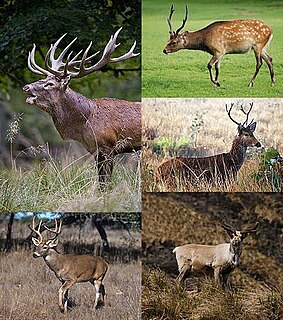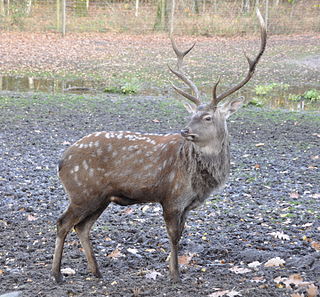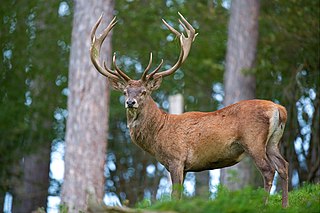Related Research Articles

Deer are the hoofed ruminant mammals forming the family Cervidae. The two main groups of deer are the Cervinae, including the muntjac, the elk (wapiti), the fallow deer, and the chital; and the Capreolinae, including the reindeer (caribou), the roe deer, and the moose. Female reindeer, and male deer of all species except the Chinese water deer, grow and shed new antlers each year. In this they differ from permanently horned antelope, which are part of a different family (Bovidae) within the same order of even-toed ungulates (Artiodactyla).

Stag beetles are a group of about 1,200 species of beetles in the family Lucanidae, presently classified in four subfamilies. Some species grow to over 12 cm (4.7 in), but most are about 5 cm (2.0 in).

Gwydion fab Dôn is a magician, hero and trickster of Welsh mythology, appearing most prominently in the Fourth Branch of the Mabinogi, which focuses largely on his relationship with his young nephew, Lleu Llaw Gyffes. He also appears prominently in the Welsh Triads, the Book of Taliesin and the Stanzas of the Graves.
In Welsh mythology, Gilfaethwy was a son of the goddess Dôn and brother of Gwydion and Arianrhod in the Fourth Branch of the Mabinogi.
In Welsh mythology, Math fab Mathonwy, also called Math ap Mathonwy was a king of Gwynedd who needed to rest his feet in the lap of a virgin unless he was at war, or he would die. The story of Math is the fourth of the Four Branches of the Mabinogi.
Arianrhod is a figure in Welsh mythology who plays her most important role in the Fourth Branch of the Mabinogi. She is the daughter of Dôn and the sister of Gwydion and Gilfaethwy; the Welsh Triads give her father as Beli Mawr. In the Mabinogi her uncle Math ap Mathonwy is the King of Gwynedd, and during the course of the story she gives birth to two sons, Dylan ail Don and Lleu Llaw Gyffes, through magical means.
Lleu Llaw Gyffes is a hero of Welsh mythology. He appears most prominently in the Fourth Branch of the Mabinogi, the tale of Math fab Mathonwy, which tells the tale of his birth, his marriage, his death, his resurrection and his accession to the throne of Gwynedd. He is a warrior and magician, invariably associated with his uncle Gwydion.
Dylan ail Don is a character in the Welsh mythic Mabinogion tales, particularly in the fourth tale, "Math fab Mathonwy". The story of Dylan reflects ancient Celtic myths that were handed down orally for some generations before being written down during the early Christian period by clerics. The story as it has been preserved therefore exhibits elements and archetypes characteristic of both Celtic pagan and Christian mythologies. His name translates as "Dylan the Second Wave", referring to him as being the second born of Arianrhod.

The Père David's deer, also known as the milu or elaphure, is a species of deer that went extinct in the wild, but has been reintroduced in some areas. The milu is native to the river valleys of China, where it prefers wetland habitats. It grazes mainly on grass and aquatic plants. It is the only extant member of the genus Elaphurus. Based on genetic comparisons, Père David's deer is closely related to the deer of the genus Cervus, leading many experts to suggest merging Elaphurus into Cervus, or demoting Elaphurus to a subgenus of Cervus.

The sika deer also known as the spotted deer or the Japanese deer, is a species of deer native to much of East Asia, and introduced to various other parts of the world. Previously found from northern Vietnam in the south to the Russian Far East in the north, it is now uncommon in these areas, excluding Japan, where the species is overabundant.

Deer have significant roles in the mythology of various peoples located all over the world.

The red deer is one of the largest deer species. The red deer inhabits most of Europe, the Caucasus Mountains region, Asia Minor, Iran, parts of western Asia, and central Asia. It also inhabits the Atlas Mountains region between Morocco and Tunisia in northwestern Africa, being the only species of deer to inhabit Africa. Red deer have been introduced to other areas, including Australia, New Zealand, United States, Canada, Peru, Uruguay, Chile and Argentina. In many parts of the world, the meat (venison) from red deer is used as a food source.

Welsh mythology consists of both folk traditions developed in Wales, and traditions developed by the Celtic Britons elsewhere before the end of the first millennium. As in most of the predominantly oral societies of prehistoric Britain, Welsh mythology and history were recorded orally by specialists such as druids. This oral record has been lost or altered as a result of outside contact and invasion over the years. Much of this altered mythology and history is preserved in medieval Welsh manuscripts, which include the Red Book of Hergest, the White Book of Rhydderch, the Book of Aneirin and the Book of Taliesin. Other works connected to Welsh mythology include the ninth-century Latin historical compilation Historia Brittonum and Geoffrey of Monmouth's twelfth-century Latin chronicle Historia Regum Britanniae, as well as later folklore, such as the materials collected in The Welsh Fairy Book by William Jenkyn Thomas (1908).
The Four Branches of the Mabinogi or Pedair Cainc Y Mabinogi are the earliest prose stories in the literature of Britain. Originally written in Wales in Middle Welsh, but widely available in translations, the Mabinogi is generally agreed to be a single work in four parts, or "Branches." The interrelated tales can be read as mythology, political themes, romances, or magical fantasies. They appeal to a wide range of readers, from young children to the most sophisticated adult. The tales are popular today in book format, as storytelling or theatre performances; they appear in recordings and on film, and continue to inspire many reinterpretations in artwork and modern fiction.

The barasingha, also called swamp deer, is a deer species distributed in the Indian subcontinent. Populations in northern and central India are fragmented, and two isolated populations occur in southwestern Nepal. It is extinct in Pakistan and Bangladesh.
Hychddwn Hir appears in the fourth of the Four Branches of the Mabinogi and is one of the sons of Gwydion and Gilfaethwy, brothers who were transformed into pigs as punishment for rape. They had two other sons: Hyddwn and Bleiddwn.
Bleiddwn appears in the fourth of the Four Branches of the Mabinogi and is one of the three sons of Gwydion and Gilfaethwy. As punishment for the rape of Goewin, Math banished his nephews, turning them into a breeding pair of deer for a year, then pigs, and finally wolves. They had three children over the three years: Hyddwn, Hychddwn, and Bleiddwn. Bleiddwn is the offspring of the wolf pairing. Math took him and transformed him into a human being, baptising him Bleiddwn ("Wolf-man").

The Island of the Mighty is a fantasy novel by American writer Evangeline Walton, the earliest in a series of four based on the Welsh Mabinogion. It was first published in 1936 under the publisher's title of The Virgin and the Swine. Although it received warm praise from John Cowper Powys, the book sold poorly, and as a result none of the other novels in the series reached print at the time. Later rediscovered by Ballantine Books, it was reissued under the present title as the eighteenth volume of the Ballantine Adult Fantasy series in July, 1970, with an introduction by Lin Carter and a cover by Bob Pepper. It has been reprinted a number of times since, and gathered together with Walton's other Mabinogion novels by Overlook Press as the omnibus The Mabinogion Tetralogy in 2002. The novel has also been published in translation in several European languages.
Math fab Mathonwy, "Math, the son of Mathonwy" is a legendary tale from medieval Welsh literature and the final of the four branches of the Mabinogi. It tells of a vicious war between the north and the south, of the birth of Lleu Llaw Gyffes and Dylan ail Don, of the tyngedau of Arianrhod, and of the creation of Blodeuwedd, a woman made of flowers. The chief characters of the tale are Math, king of Gwynedd, his nephew Gwydion, a magician, warrior and trickster, and Gwydion's own nephew, Lleu, cursed by his mother Arianrhod.

The Indian hog deer is a small deer whose habitat ranges from Pakistan, through northern India, to mainland southeast Asia, which inhabits much of the Indo-Gangetic Plains of Pakistan, northern India, Nepal, Bangladesh, southwestern Yunnan Province in China, all the way to western Thailand. Introduced populations also exist in Australia and Sri Lanka.
References
- Ifans,Dafydd & Rhiannon, Y Mabinogion (Gomer 1980) ISBN 1-85902-260-X